Support and Resistance: The Ultimate Guide to Price Action Charts
A major proponent of becoming a successful and profitable price action trader is marking the key support and resistance levels.
Where traders mark their levels is crucial to making high probability trades and it is vital that traders get it right if they want to be successful.
In this tutorial, I will go through the exact processes that traders need to use, including the routine that traders should go through to mark up their charts, the time frame charts they need to use to have the most accurate levels and exactly how traders can use price flips to trade on the right side of the market when price makes a quick break either higher or lower.
This trading lesson is one of the most in-depth lessons on the Forex School Online website because it is crucial that traders get their processes around key levels correct.
Having the best routine will not only help you find better trades, but will also cut out many hours every week of going through the same charts when it is unnecessary.
How to Find Support and Resistance Levels
The best way for traders to mark their charts with support and resistance, is to mark them up before even looking for a trade. It is very important they do it this way around and not after they have already found a trade because it can cut down on a heck of a lot of time and also cut down on a lot of false trades that are not from the best key areas.
Traders need to go through their charts at the start of the week and mark their key support and resistance levels that they want to make trades from on the daily charts.
The daily charts are the best and most clear charts to mark levels from and these levels on the daily charts can be used to make trades from on the intraday charts. For example; trades on the 4hr and 8hr charts can be made using the same levels that have been marked using the daily chart.
The reason it is highly advisable traders mark their levels on the daily charts and then also use these levels to make trades with their intraday trades such as the 4hr chart, is because the smaller the time frame the more levels there become and the weaker the levels also tend to become.
How to Draw Support and Resistance Lines
Trading from the daily chart levels no matter what the time frame ensures that the trader will always be making trades from key support/resistance level, rather than a possible weak intraday level.
If the trader does it the opposite way around and marks their levels after they have spotted the trade setup such as a pin bar or engulfing bar, etc., their brain can often play tricks and see the support and resistance because the trader wants to confirm the trade and enter the setup.
Often when doing this the trader will find a support or resistance that really is not there to be found or convince themselves of the trade. Other traders will be filled with doubt about if the area they are entering at really is a solid one.
If however, the trader marks their levels first, this risk is taken away and the trader is always assured of entering from good areas of support or resistance. All the trader has to do then is mark their key levels and wait for price to move into one of their pre-marked levels and then look for a price action setup.
This way there can be no confusing if the price has moved into a key level because the levels are pre-marked before a trade setup even forms.
Stop Wasting Hours With Trade Hunting
Marking up charts this way also cuts down on time. If the trader is hunting for setups in every time period and then looking for the support and resistance, they have to look at every chart in every time period to check if a trigger signal has been formed. If they do find a setup, they then have to work back to see if it matches up with a support or resistance level.
If a trader is to trade the 4hr, 8hr and daily chart this would mean that every time that one of these time frame closes they would have to go through every single chart to see if a signal has formed and then if a signal has formed, they then have to work back to see if it has formed at a good level.
This severely limits how much the trader can get through and also adds a lot of time to the whole process.
The most efficient and fastest way to have charts set up is to have it so that traders can just quickly flick through the daily time frame charts one by one to see if price has reached any of the support or resistance levels that have already been pre-marked and only then, stop if price has moved close to any of the key levels.
If price moves in close to any of the daily pre-marked levels, then the trader can start to hunt for trades at this level by either looking for trades on the daily chart or if there is no price action on the daily chart, going down to the intraday charts such as the 8hr & 4hr charts to look for setups.
Doing it this way ensures that price action traders are always only hunting for trades at key levels and it also cuts out a heck of a lot of time because they are not going through a lot of unnecessary charts they would be with the other method.
Traders are not going through every single individual 4hr & 8hr chart every time they close and looking for a signal like the other method.
The only time they move to these charts is when price is at their key pre-marked level and they are hunting for a trigger signal. This literally cuts out hours.
Don’t Forget Why Support & Resistance is Marked
Quite often traders get into a habit of marking their levels on their charts and they have all these pretty charts with levels on them, but before long they have forgotten what the reason is for marking support and resistance in the first place.
They have 10+ levels all over their charts that are doing absolutely nothing whatsoever and even most of the levels closest to the price are pretty much useless when it comes to the crunch.
With the method I described above of pre-marking levels first and then letting the market come to you so that you are not letting the market dictate terms, it is important that you remember exactly why you marked your levels.
The only reason support and resistance levels are ever marked is because the level is a very good one and the trader thinks if price makes it back to the level, it could be a high chance of making a high probability trade. It is important that traders keep this in mind when marking their levels.
I often see a lot of charts where very minor levels are marked and these levels are often the levels where if price does make it back to, the trader is not going to make a trade entry from, so to mark the level is just a waste of time. The only levels that ever need to be marked are the levels where traders are going to want to make trades from if price makes it back to.
All the other targets and stops etc, are all worked out well after a trade is found, but before that a trade has to be identified and to do that solid key levels are needed.
Always remember when looking for levels; you only want to mark a level if you are going to want to play a trade from it. If it is a minor level or a level you would not play a trade from then it is a waste of time putting it on your chart and just getting in the way of the price action.
To Use Candlesticks, Line or Bar Charts?
Price action traders are not just pattern traders and can use a lot of information from a price action chart to help with their trade. With this in mind; candlesticks offer price action traders a lot of help with what they need because they show traders not only the open and close, but also where price went during the session.
For this reason, when marking support and resistance the candlestick chart should always be used.
The major problem with the line charts when marking support and resistance is that it can cut off the swing points and smooth out the price action out, not showing the true extent of the swing highs and lows, whereas with the candlesticks, traders get to see everything.
When using candlesticks, traders can also read more information from candle to candle when marking support and resistance that cannot be achieved with line charts.
When traders are marking levels they need to take into account both the wicks and the bodies of the candlesticks to match up the best levels.
With candlesticks traders will also be able to see whether price has been able to close above or below a key support/resistance level and this can be crucial on occasions to telling whether a level has broken or held. I go into depth about how traders can tell whether a level has been broken or contained in this lesson here:
The Lessons Traders Can Learn From Candlesticks & Price Action
Keeping Charts Clean to Read the Price Action
It is super important that traders remember they are price action traders and not fall back into having squiggly lines all over their charts with 15 different support & resistance levels all over their charts. All that is needed are two levels maximum (sometimes less); one level above price and the other below price. That’s it.
If price breaks one of the two levels, then price is reassessed and a new level is placed in the new spot. It is however, very important that the chart is kept clean and not overrun by other things taking over the chart so that traders can at all times read what is happening with the price action because the price action is king.
Whilst traders who have been trading price action for a while will look at the chart below and either laugh or think it is a joke, the chart below is exactly how thousands upon thousands of traders charts look all around the world.
None of the things on the chart are helping the trader and more to the point; the actual support and resistance levels that are on the chart are not doing their job. Remember: keep your charts clean! Remember what the levels are for and you always need to be able to read the price action.

Whilst a lot of charts are going to have two levels on them, that does not mean every chart will always have two levels. As discussed above; the whole reason for marking levels is so that traders have a pre-marked level for hunting trades. Don’t fall into the trap of thinking that you have to mark levels on every single chart.
Keep in mind that some charts you will not mark a level because there just are not clear enough levels to be marked and the question you need to ask yourself as a trader when looking for levels is; “If I am struggling to mark a support or resistance level, do I then want to make any trades in this pair when I can’t confidently mark any levels?” and the answer is definitely, no.
Some markets you will mark one level and then in others you will have no levels to mark at all.
An example of where you may only have one level is in a trending market where because the trend is so strong you may be looking to trade only with the trend so the level you mark is from support or resistance within the current trend.
An example of when you would not mark any levels is when price is so choppy or in such a tight consolidation period that you are waiting for price to break out and for the market to show its cards first before you then look to mark some clearer levels.
The best trades are played from the best key support and resistance levels and these levels should be plainly obvious. If it takes you a really long time to find a level on a chart, then the chances are that the level is not an obvious level that you should be looking to take trades from and the only levels you need marked on your charts are the levels you want to look to take trades from.
Support and Resistance Zones: Draw Only the Swing Points
Traders need to have a set routine for when they go through their daily charts and mark up their levels. For me, I go through my charts each Sunday night and mark all my levels for the following week. I look for all the levels I am looking to make possible trades at for the week ahead. If the price, then breaks any of those levels during the week I will reassess and mark a new level.
With this mindset of traders marking levels at key areas that they want to make trades at and not just any areas of support and resistance, it is a good approach to look for levels. The best and easiest way to mark support and resistance is to look from the top of the chart down and start matching the swing points.
A swing point is simply a point where price has made a run either higher or lower and found support or resistance and then reversed the other way. See the chart below for an explanation for what a swing point is;
Chart 1: The chart below shows a chart with the obvious swing points marked without the key levels. This is how a trader could look at it if they were at the stage where they were trying to work out what a swing point is and from there they could then match the swing points up to mark their key levels.
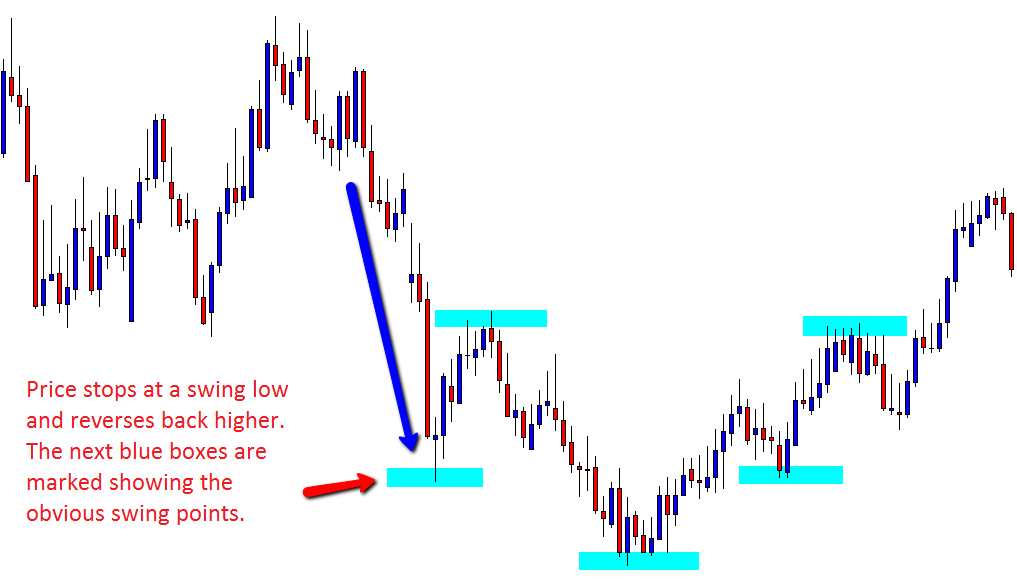
Chart 2: The chart below still has the swing points marked, but it now has the key levels marked and shows how by using the obvious swing points you can mark the levels on the charts.
You can also use previous price action information and swing points when marking these levels because you will often notice that if price is finding support or resistance at a key level now, there is a high chance it also did in the past.

Match Up Your Obvious Swing Points
Keep in mind that support and resistance is a very basic fight between the bulls and the bears or the buyers and the sellers. When the bulls (buyers) push the price higher it will eventually move into resistance where bears (sellers) will move price lower. When the bears (sellers) move price lower, price will eventually move into support where the bulls (buyers) will gain control and push price higher.
The charts below shows how traders can match these obvious swing points to mark their key support and resistance levels on the daily chart, keeping in mind they don’t want levels just all over the chart, but rather above and below the price.
Chart 1: The chart below shows a chart with key levels both above and below price that a trader may be using to hunt for trades.
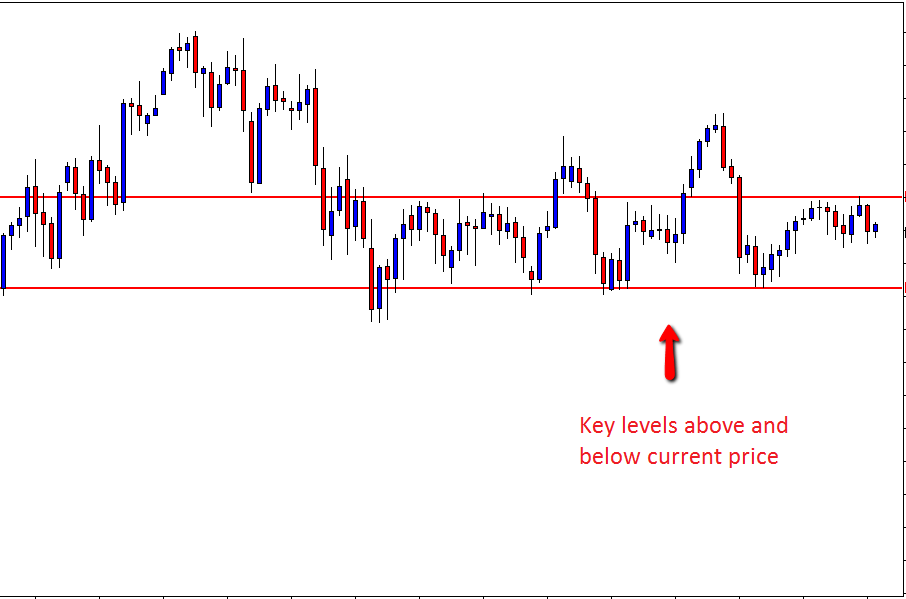
Chart 2: The chart below is in an up-trend and only has one clear support level that is marked where the trader could be looking to hunt for a long trade within the trend.
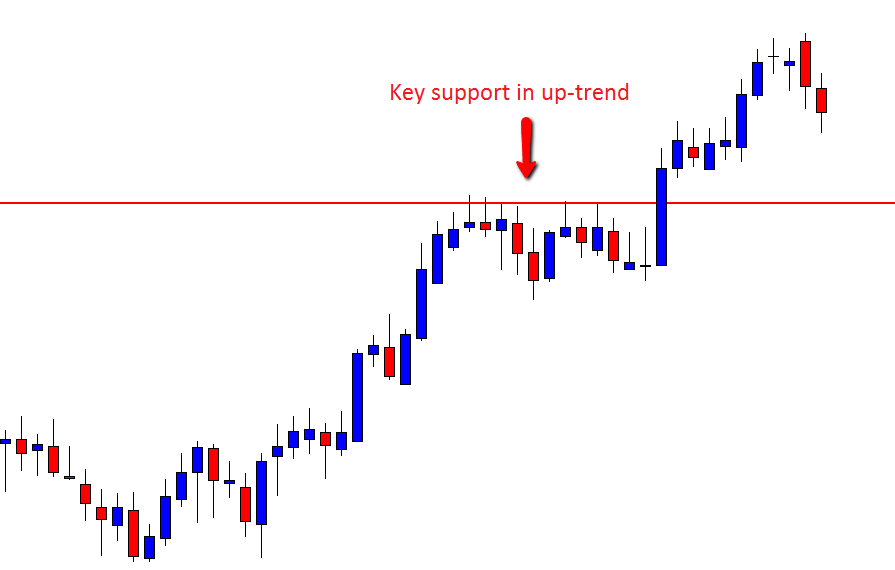
Marking Levels With Price Flips
“Price Flip” levels are levels where the price has done just as the title says and that is; it has found either a support or resistance level and it has flipped to become a new level. For example; price may be holding as a solid support level and then price breaks through the support level and this level could become a price flip level and look to become a new resistance level.
This is a pattern that works time and time again in the Forex markets and is one of the best lessons traders can learn for marking their charts and also looking for high probability trades.
Old levels are constantly flipping and holding as new levels and this can happen from as far back as years that price will continue to flip and respect the same price flip level.
It doesn’t matter how many times the level acts as a price flip because the same principals apply which is that old support becoming new resistance and vice versa, old resistance becoming new support. The chart below shows how a price flip works in action;
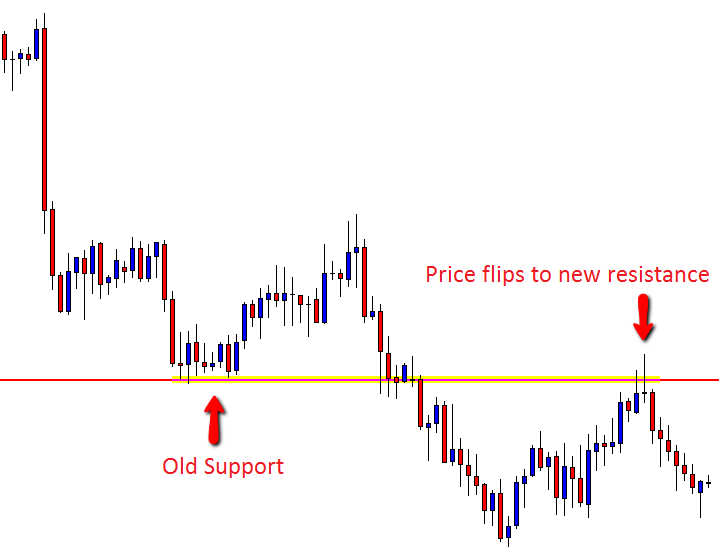
For traders to make trades with price flips and mark them into their charts, they need to be able to mark these price flip levels before they have been confirmed.
What I mean by that is; a lot of the time when traders are marking these new price flip levels, the price would have just broken out of a new support or resistance level and the trader will be looking for that same level that price broke out of to hold as a new price flip level.
This level will not, as yet be confirmed as a new level, so traders need to make sure that when they are taking trades from these price flip levels that they enter with solid and high probability price action trigger signals.
An example of this scenario is; price breaks lower and through support. Price moves back higher and into this new level that the trader is now looking to hold as a new resistance level.
This is a new price flip level and it is not confirmed yet because price has not rejected it in any way. Because it has not been confirmed we cannot be sure that price will reject it, so traders need to ensure they use high probability price action at this level to confirm the rejection. These price flip levels in the trends can be super levels to look for trades.
The chart below highlights how a pin bar could be taken at a price flip level after price broke through the support and then reversed back up to test the new price flip resistance level. See the charts below for further explanation on how a price flip could work out;
Chart 1: Price moves lower and finds support. Price stalls, before finally bursting through the support level and continuing lower.
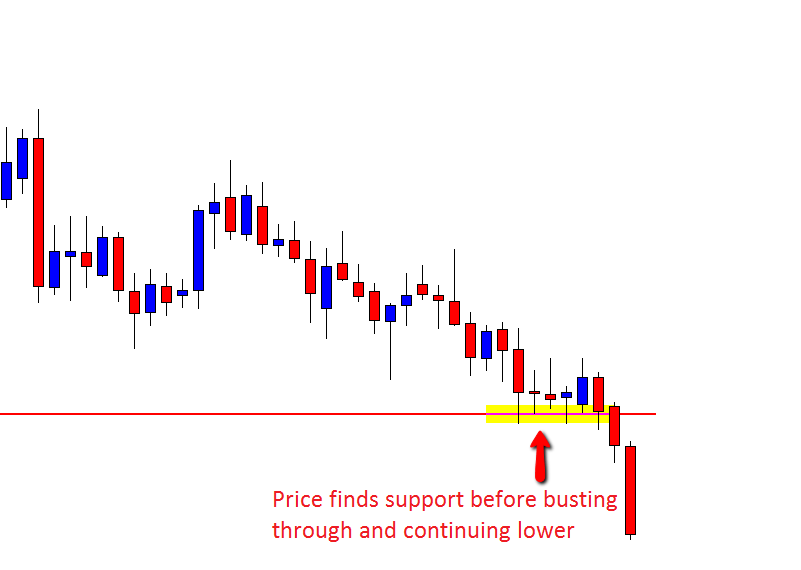
Chart 2: Price retraces back higher to test the old support area which is now looking to become a price flip and new resistance area.
This old support level is yet to be confirmed as a new resistance level and price could potentially cut straight through it and back higher like a hot knife through butter. Whilst these levels can be super areas to take trades from, it is also important that traders ensure they are using high probability trigger signals to to confirm the levels.
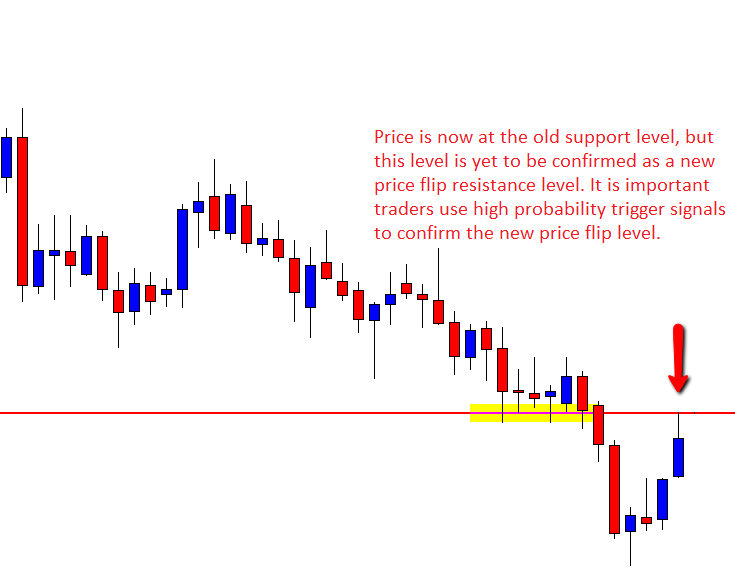
Chart 3: Price fires off a pin bar reversal at the new price flip resistance area which is rejecting the resistance. This trigger signal is the confirmation the trader needs to enter a trade at this new key level.
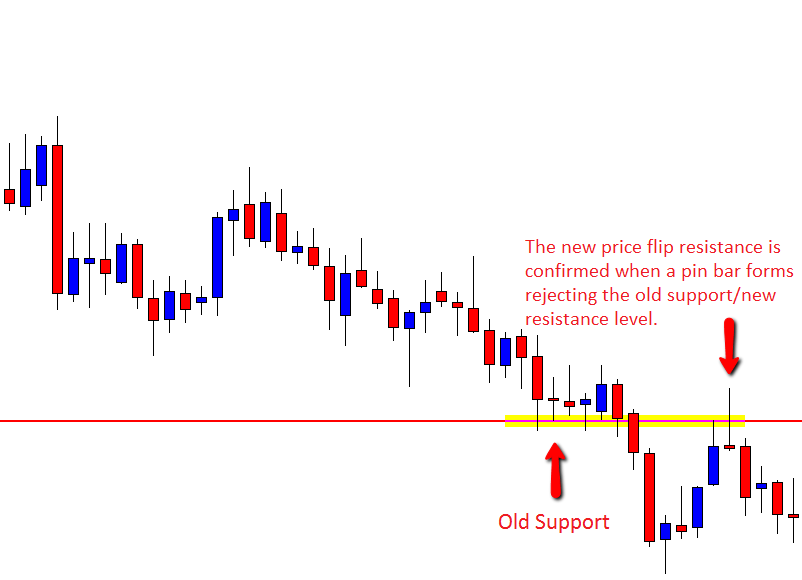
Putting it Altogether – Keep it Simple!
The major reason I have made this longer style tutorial on how traders should go about marking their support and resistance levels is because I often get emails from traders who are worried that they are not doing it right or that they are not getting where they want to be quick enough.
The vast majority of these traders are doing the basics correctly, but their processes and how they actually go about marking their levels is slowing them down.
Their routines are costing them hours and their mindset is on just finding trades; not the best price action story and then the trade.
I really hope you have enjoyed this in-depth trading lesson on how to mark your key support and resistance levels, the process you need to take when marking them and the mindset that is needed.
If you have any questions or comments post them in the comments below.
Safe trading,
Johnathon
Join The Telegram Group To Get Your Support and Resistance
- Instant Access To The Beginners Course
- FREE Trading Signals
- Start Making 700 pips per week


How do I know where to make a trade entry?
Hi Francis,
you can find a lot of free strategies including entry strategies here; https://www.forexschoolonline.com//blog
You can also use search at bottom of each page to find what topics you want to learn more about.
Johnathon
hi Johnathon
is it right to wait for the price to find a S/R, then check to see whether we have a confluent level in near price history then we can draw a true S/R line ?
regards
Hi Mehdi,
we are marking proven support and resistance levels that have held in the past and then watching the price action at these levels using the other price action story information.
Safe trading,
Johnathon
What a great and concise piece on support and resistance zones. I love it.
Stay blessed bro!
Thanks Olatunji,
great to have you,
Johnathon
I thought I knew all about support and resistance until I read this piece from you. Thanx so much for your dedication and quest to see us all succeed in this dreaded forex market.
Great piece and God bless u
thank’s
👍
Good evening, excellent article, I have a little doubt, the supports and resistances could be placed in 00 and 000? they say that these levels are institutional, thanks for this great contribution and happy Christmas.
I think you are referring to VBRN = very Big Round Numbers here?
Very Big Round Numbers often work very similar to S/R as psychologically levels; ie, people watch and trade around them, maybe not right on them, but setting orders slightly above, slightly below or waiting to break.
When it happen repetitively it becomes S/R and it happens even further and even more begin to watch and trade the same level. We have a few of these recently in the charts in focus.
Safe trading,
Johnathon
Hi Sir,
Am Eddy from Malaysia, before I found your article and also your video, I actually are still learning S&R and also Key level/Confluence , but yet I still having a problem which I failed to look for the Key Level which I shall waiting for the Price Action, I do hope that Sir could help me off the problem that I m facing now.
Thank You Sir
Happy to help Eddy.
Just let us know in more specific details what the problem is.
Safe trading,
Johnathon
Johnathon thank you and thank you!
You’re doing a great job
But please sir I am still having difficulty understanding how to mark swing points,you choose some swing points and Mark ,while you leave some others . So how do I know the ones to mark and the ones I should not mark
Hello…. Marking Support And Resistance Levels On A Daily Chart And Using Same Levels On 4hr Or 8hr Timeframe Is Good.
But In The Case Of Mt4, After Marking These Levels Changing To Another Timeframe Will Erase The Levels, So What Do I Have To Do ?
Hi Browyn,
MT4 holds your levels from where you mark them on all time frames. For example; you mark a level on a daily, then you can flip through to 4 hour, 1 hour or any chart and the same level will be there.
If you are having an issue where after marking your levels they are not still there when you turn your MT4 off and turn it back on, then please try creating and saving a profile. Read about how to do this in our MT4 guide; https://www.forexschoolonline.com//beginners-guide-metatrader-4-mt4/
Johnathon
Another great stuff!!
Thanks Johnathon
Be Serious, Know what your doing. Please, Goldman Sachs made a fortune today.They are the makert. They front run your trades and know where all the money is and go against it. Got to be a Bull. Why ? Bad internals, no conviction on the buy side. Unless, YOU are ONE of the Goldman Guys who gets the phone call and the trade. Think, your smarter than, Got to be a Bull . Would, No fear in the makerts be the biggest of warnings ? Have a Great Weekend.
Heya Elizabet,
Goldman’s has already abandoned 5 out of their 6 biggest trade calls that they put out each year for the 2016 ALREADY with one remaining, http://www.theglobeandmail.com/globe-investor/investment-ideas/goldman-sachs-abandons-five-of-six-top-trade-calls-for-2016/article28666669/
To be honest though it really does not matter or affect us either way whether their trades tank or make billions. I guess it shows that their trade calls can go south the same as us, but at the end of the day they have sections within their bank doing the same thing we are; trying to make money.
Yes, there are many different participants in the markets. Those that are there to build the market, those that are there to make money by facilitation currency exchange for other companies for import/export which banks do, and then there are the traders/speculators.
Banks have these and the do the same things as us; the look to build an edge over the market. Did you ever hear about the large scandal where the National Australia Bank lost $360 million dollars on their Forex arm mind 2000’s? http://www.smh.com.au/articles/2004/03/12/1078594547046.html
For you as a trader you need to focus on what you can control and that is trading to make money using all the information in front of you, to build an edge that makes money overtime using everything that everyone is doing in the price action on the charts.
Safe trading,
Johnathon
Great article . It definitely gave me a much better idea on where I should improve on marking key S & R areas . Thank You 🙂
Sir so Nice article its very informative.Thank You sir.
Thank you very much for Johnathon. It is very important article. And how i save it in my computer or print it. Because sometimes i go in place no internet therefore i need print it or save my computer.
What you give away is worth a lot. THANKS!!!
NICE…..Exellent……thanks
Very nice article. I'm an FSO member, but this was a really well put together reminder!
John, such an excellent lesson. Once I fear forex, forex is risky, tough, so hard to make money, but after starting reading your website, now I feel, forex is not so hard if some important rules are followed. Now I feel so much confident and all credit goes to only you.
Thank you very much Johanthaon.
You are changing my life 🙂
I pray for you.
Thanks Babul & Rob!
Keep an eye out for another lesson on trading in ranges I am about to put our real soon I think you will both enjoy! If you do enjoy let me know your thoughts with a comment or your thoughts/questions etc,
Johnathon
Excellent post Johnathon! Thank you for relentlessly showing us the "light"
Johnathon.
Very good summary here. 🙂
I have finaly figured out the S/R system and findibg entries and stops in a good manner thanks to your excellent advises.
Started a demo on Pepperstone mid feb, 5K usd, has now turned to 22K usd!
My Live account follows the positive direction with smaller steps though, since I am a littel more carefull here. Positive the last month though.
Thanks again for your TOP guidance.
Your dedicated lifetime student,
Henning
WOW!!! Great going Henning!
It is great to see your dedication and hard work starting to pay off. Keep up the good work and continue to prosper mate!
All the best,
Johnathon